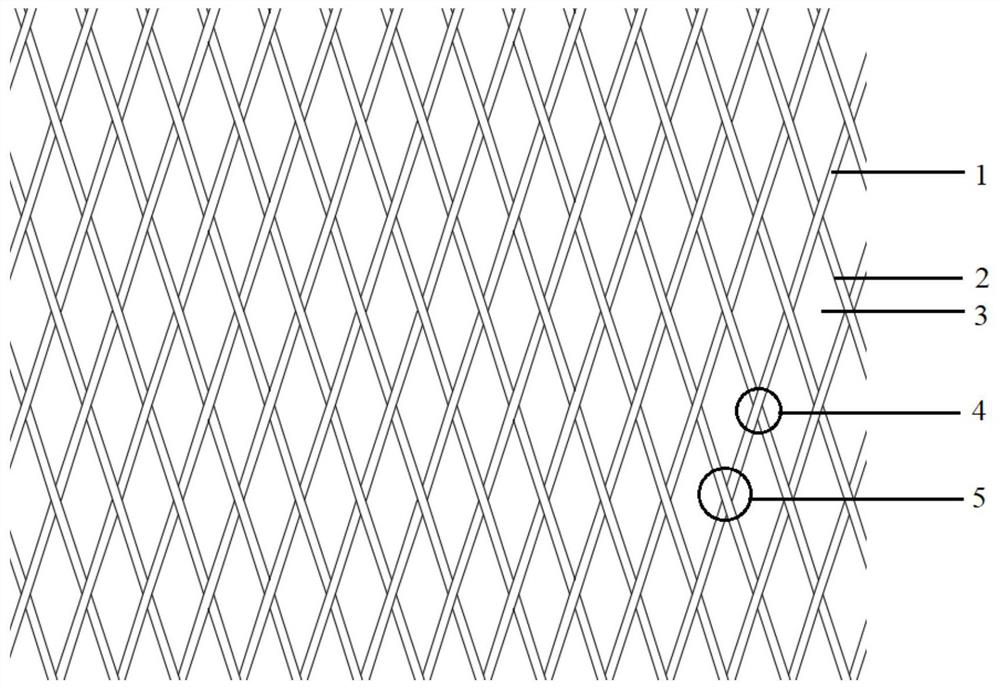Low thrombogenic intracranial vascular woven stent and processing method thereof
A technology of intracranial blood vessels and braided wires, which is applied in the field of braided stents and their processing, can solve the problems of substandard surface treatment, easy breakage of metal wires, and decreased mechanical properties of stents, so as to achieve less metal surface defects and avoid Mechanical properties, avoiding a sharp drop in effect
- Summary
- Abstract
- Description
- Claims
- Application Information
AI Technical Summary
Problems solved by technology
Method used
Image
Examples
Embodiment 1
[0057] Such as figure 1 As shown, this embodiment is a braided stent for intracranial blood vessels after surface treatment. The stent is braided by cobalt-chromium alloy wire and platinum-based alloy developing wire, and a layer of dense chromium oxide passivation film is formed on the surface of the cobalt-chromium alloy wire ( The main component is Cr 2 o 3 ). The intracranial vascular braided stent includes a cylindrical tubular mesh structure body, and the mesh structure body includes several braided wires braided with each other to form a coherent mesh structure 3, and the braided wires include a warp thread 1 and a weft thread 2; Weaving points are formed after the wefts intersect, and the weaving points include positive weaving points 4 and reverse weaving points 5, wherein the weaving points at which the warp 1 position is pressed above the weft 2 are positive weaving points 4, and the warp 1 position is pressed below the weft 2 The weaving point is a reverse weavi...
Embodiment 2
[0059] Such as figure 2 As shown, this embodiment is a braided stent for intracranial blood vessels after surface treatment. The stent is braided by cobalt-chromium alloy wire and platinum-based alloy developing wire, and a layer of dense chromium oxide passivation film is formed on the surface of the cobalt-chromium alloy wire ( The main component is Cr 2 o 3 ). The intracranial vascular braided stent includes a cylindrical tubular mesh structure body, and the mesh structure body includes several braided wires braided with each other to form a coherent mesh structure 3, and the braided wires include a warp thread 1 and a weft thread 2; Weaving points are formed after the wefts intersect, and the weaving points include positive weaving points 4 and reverse weaving points 5, wherein the weaving points at which the warp 1 position is pressed above the weft 2 are positive weaving points 4, and the warp 1 position is pressed below the weft 2 The weaving points are anti-weaving...
Embodiment 3
[0061] Such as image 3 As shown, this embodiment is a braided stent for intracranial blood vessels after surface treatment. The stent is braided by cobalt-chromium alloy wire and platinum-based alloy developing wire, and a dense passivation film of chromium oxide is formed on the surface of the cobalt-chromium alloy wire. The intracranial vascular braided stent includes a cylindrical tubular mesh structure body, and the mesh structure body includes several braided wires braided with each other to form a coherent mesh structure 3, and the braided wires include a warp thread 1 and a weft thread 2; Weaving points are formed after the wefts intersect, and the weaving points include positive weaving points 4 and reverse weaving points 5, wherein the weaving points at which the warp 1 position is pressed above the weft 2 are positive weaving points 4, and the warp 1 position is pressed below the weft 2 The weaving point is a reverse weaving point 5, every two warp threads 1 form on...
PUM
 Login to View More
Login to View More Abstract
Description
Claims
Application Information
 Login to View More
Login to View More - R&D
- Intellectual Property
- Life Sciences
- Materials
- Tech Scout
- Unparalleled Data Quality
- Higher Quality Content
- 60% Fewer Hallucinations
Browse by: Latest US Patents, China's latest patents, Technical Efficacy Thesaurus, Application Domain, Technology Topic, Popular Technical Reports.
© 2025 PatSnap. All rights reserved.Legal|Privacy policy|Modern Slavery Act Transparency Statement|Sitemap|About US| Contact US: help@patsnap.com



